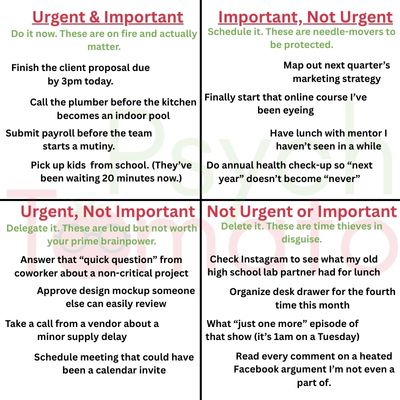Ever get to the end of the day and wonder if you did anything that actually mattered? You’re not alone.
In our always‑on world, it’s easy to confuse being busy with being productive. We spend our days putting out fires, answering emails, and checking boxes on to‑do lists that look impressive but don’t actually move us forward. It feels like progress, but it’s really just motion.
The real secret to productivity isn’t about doing more things faster; it’s about doing the right things with the time and energy you’ve got.
That’s where the Eisenhower Matrix comes in.
It’s a deceptively simple tool that helps you cut through the noise, spot what actually matters, and spend your day on the work that counts. Think of it as a pair of glasses for your priorities, where suddenly the blurry mess of “everything at once” sharpens into a clear picture of what deserves your attention.
What Is the Eisenhower Matrix?
The Eisenhower Matrix takes its name from President Dwight D. Eisenhower, who had a knack for getting things done without drowning in the urgent chaos of running a war and a country.
He’s credited with saying, “What is important is seldom urgent, and what is urgent is seldom important.” That single sentence has since inspired one of the most enduring tools in the productivity toolkit.
Here’s the idea: not all tasks are created equal, so stop treating them that way.
The Matrix divides your to‑dos into four quadrants based on urgency and importance:
- Urgent and important tasks are the ones you tackle right away (think deadlines, crises, last‑minute prep).
- Important but not urgent tasks are the long‑game moves like planning, relationship‑building, and personal growth.
- Urgent but not important tasks are the interruptions that demand attention but don’t really deserve yours, and are things you can either delegate or minimize.
- And then there are the not urgent, not important tasks, the time‑wasters and distractions that feel harmless but quietly eat up your day.
To make it concrete: preparing for tomorrow’s presentation? That’s urgent and important. Setting long‑term career goals? Important but not urgent. Replying to a non‑critical Slack ping? Urgent but not important. Watching cat videos, unless you’re a professional cat video curator, is neither urgent nor important, no matter how adorable.
The beauty of the Eisenhower Matrix isn’t in its complexity but in its clarity. It forces you to stop treating every item on your list like it’s equally valuable and instead makes you choose what truly deserves your focus.

The Science Behind Prioritization
So why do we so often get stuck in busywork instead of meaningful work?
Blame your brain’s built‑in bias for urgency. Psychologists have found that we’re wired to react to tasks that feel immediate, even if they’re trivial, because our brains crave closure. Knocking out a quick email or checking off a minor task delivers a tiny shot of satisfaction, a dopamine reward that tricks us into thinking we’re being productive.
Researchers call this the “urgency effect,” and it’s one of the biggest reasons we keep reaching for low‑value tasks while the important work sits untouched.
The problem is compounded by decision fatigue. Every time you decide what to work on next, you burn a little mental fuel. By the afternoon, when your brain is tired, it’s far easier to default to whatever is loudest, easiest, or most familiar.
That’s why you might find yourself reorganizing your desktop folders instead of finally drafting that proposal.
The Eisenhower Matrix short‑circuits both of these traps. By sorting tasks into quadrants ahead of time, you make the hard choices once, while your brain is fresh. From then on, you can follow the map instead of wrestling with the same “what should I do next?” question over and over.
It’s like putting up the bumpers on a bowling lane. You still have to roll the ball, but you’re far less likely to waste energy bouncing from one distraction to another.
Benefits: What the Eisenhower Matrix Can Do for You
The biggest gift of the Eisenhower Matrix is focus.
By deliberately scheduling the “important but not urgent” tasks, you carve out time for the things that actually move your life and work forward. These are the projects that build your career, strengthen your relationships, or improve your health. You know, the kinds of goals that rarely scream for attention but quietly shape your future.
When you consistently make space for them, you sidestep the last‑minute panics that come from neglecting them until they become crises.
Of course, there’s also a psychological payoff. When you’re clear on your priorities, you spend less time firefighting and more time doing work that feels actually meaningful. That clarity reduces stress, because instead of juggling everything at once, you know exactly why you’re doing what you’re doing. It’s the difference between running in circles and walking a straight line.
But perhaps most importantly, the Eisenhower Matrix also gives you a built‑in filter for saying no.
Once you’ve sorted your tasks, it becomes much easier to spot the ones that can be delegated, delayed, or deleted entirely. Saying no stops feeling like a personal failure and starts feeling like good time management.
It’s a fantastic tool for restoring a sense of control. Instead of being pulled in a dozen directions by whatever’s loudest, you can point to your quadrants and say, “This is where my time is going and here’s why.”
Related: Time Management Strategies to Take Back Your Day (and Your Sanity)
Limitations and Common Mistakes
Of course, even the best system has its pitfalls.
The most common trap is misclassifying tasks. If you’re not brutally (and I do mean BRUTALLY) honest about what’s truly important, you’ll end up stuffing everything into the “urgent and important” quadrant. That quadrant should be reserved for genuine deadlines and crises, not for every request that lands in your inbox.
You need to be wary of overfilling Quadrant 1. If everything feels urgent, you’re back where you started, which means you’re right back to constantly firefighting and never making progress on the long game.
The real goal of the matrix is to spend more of your time in Quadrant 2, the important‑but‑not‑urgent zone, where planning, learning, and relationship‑building happen. That’s the quadrant where stress goes down and momentum goes up.
And then, of course, there’s the trap of productivity theater. It’s easy to get caught up in doing lots of urgent things that look productive (answering emails, attending meetings, checking off small tasks) without ever asking whether they actually matter.
You feel busy, but you’re not moving closer to your goals.
The way around these pitfalls is simple, but not always easy: be ruthless about what’s truly important, review your matrix regularly, and don’t be afraid to delete tasks that don’t deserve your time.
Remember, “not urgent and not important” isn’t a quadrant to be politely ignored. It’s a quadrant that exists to remind you that some things really can go.
How to Use the Eisenhower Matrix in Real Life
So, how do you actually put this into practice?
Start by writing down everything on your plate for the day or the week. Big or small, urgent or not, get it all out of your head and onto paper (or into your favorite app). Once you’ve got the list, the real work begins: sorting each task into its proper quadrant.
This is where honesty seriously matters. If you label everything as urgent and important, you’re not prioritizing and you’re just recreating the same overwhelm in a prettier format.
Once your tasks are sorted, the path forward becomes clearer.
Urgent and important items are your immediate action list: the deadlines, the crises, the things that simply can’t wait.
Important but not urgent tasks are the ones you want to schedule into your calendar before they turn into emergencies. These are the investments in your future self: the report that’s due next week, the workout you’ve been meaning to fit in, the planning session that will save you headaches later.
Urgent but not important tasks are the interruptions and requests that matter to someone, but don’t necessarily require you. Delegate them, batch them, or handle them quickly without letting them hijack your day.
And then there’s the not urgent, not important tasks: the distractions, the busywork, the “just one more scroll” moments. Those are the ones you can delete or defer without guilt.
The Eisenhower Matrix in Practice
So let’s get out of the theory side and see what it looks like in practice.
Imagine you’ve got a big report due next week. That’s important, but not urgent, so you block time on your calendar now to chip away at it in manageable sessions (perhaps even using the Pomodoro technique for some extra productivity oomph!).
Meanwhile, an admin request pops up that feels urgent but doesn’t require your expertise. That’s a perfect candidate to delegate. And when an optional webinar invite lands in your inbox? That’s a not urgent, not important item you can skip without a second thought.
The Eisenhower Matrix works best when you treat it as a living system, not a one‑time exercise. Review your quadrants regularly (weekly is a good rhythm) because priorities shift, and so should your focus.
The more you practice, the faster you’ll get at spotting which quadrant a task belongs to, until it becomes second nature.
Tomato Takeaway: Prioritizing for Real Impact
At the end of the day, productivity isn’t about how much you do, but what you choose to do. The Eisenhower Matrix is a simple but powerful way to cut through the noise and focus on the tasks that truly matter. By separating urgency from importance, you give yourself explicit permission to stop reacting to every little ping and distraction and start directing your time with intention.
Try it for a week or two! Write down your tasks, sort them into quadrants, and see what happens when you start protecting time for the important but not urgent work. Chances are, you’ll not only get more done, but you’ll also feel less stressed and more in control of your days.
And if you’ve already experimented with the Eisenhower Matrix, think back to your biggest “urgent vs. important” aha moment. Was it realizing how much of your day gets eaten by other people’s urgencies? Or noticing how neglected your long‑term goals had become?
Share your story in the comments! We’d love to hear how this deceptively simple tool reshaped the way you work!
Fueled by coffee and curiosity, Jeff is a veteran blogger with an MBA and a lifelong passion for psychology. Currently finishing an MS in Industrial-Organizational Psychology (and eyeing that PhD), he’s on a mission to make science-backed psychology fun, clear, and accessible for everyone. When he’s not busting myths or brewing up new articles, you’ll probably find him at the D&D table or hunting for his next great cup of coffee.


